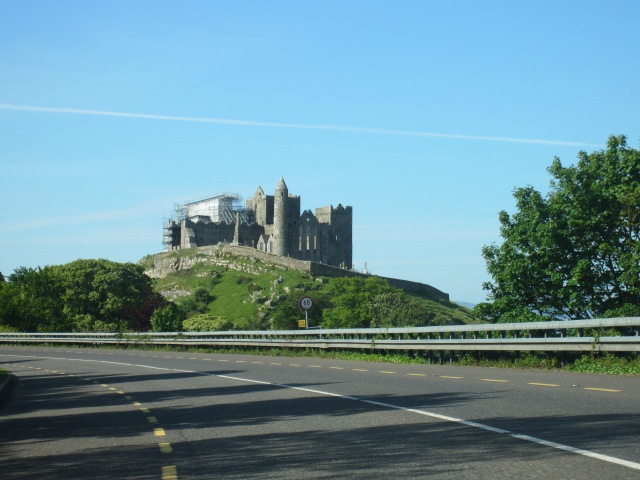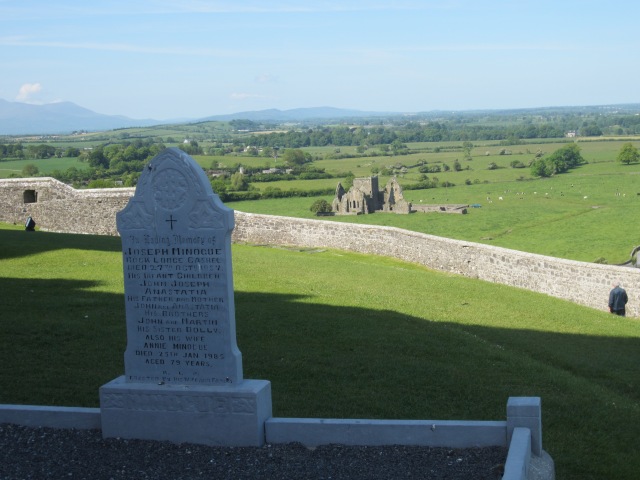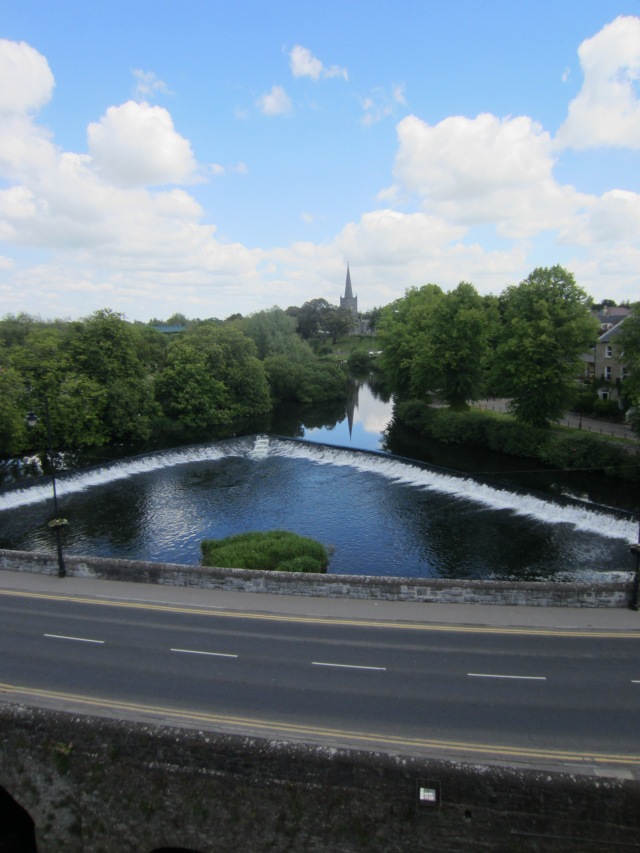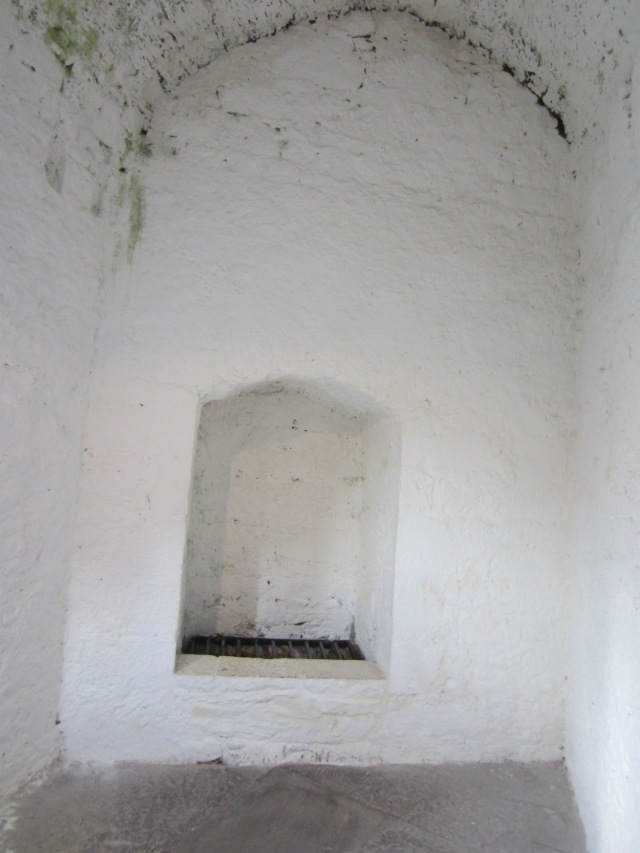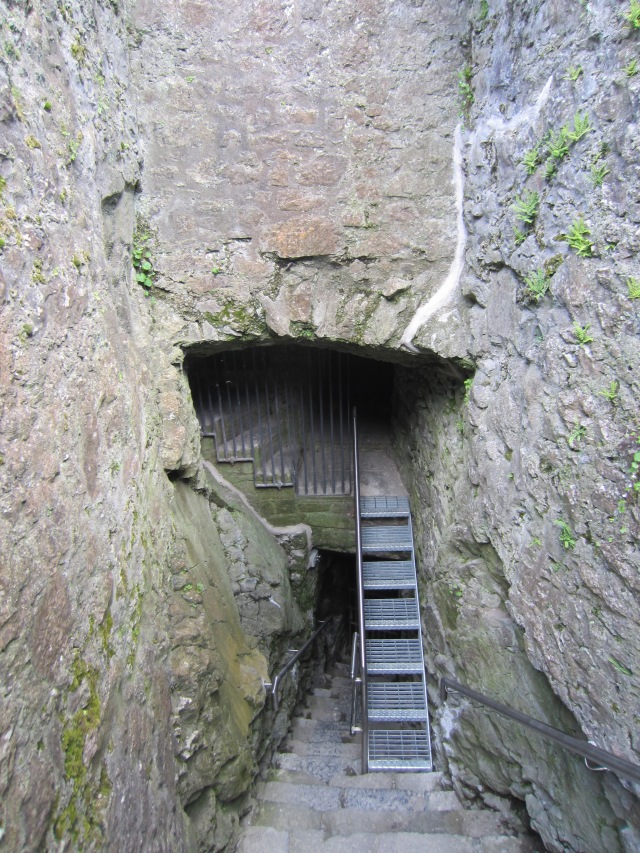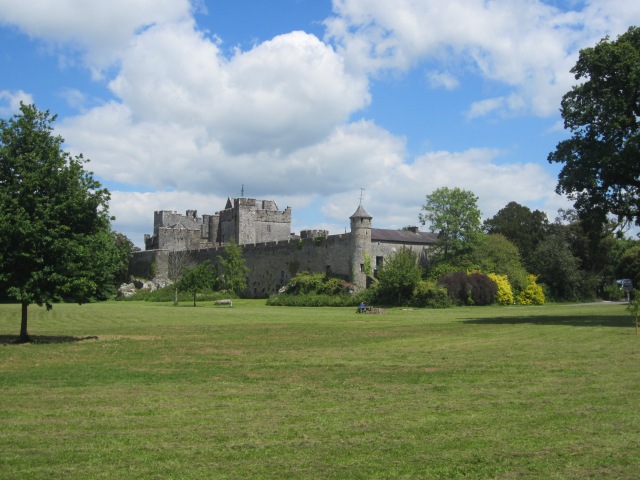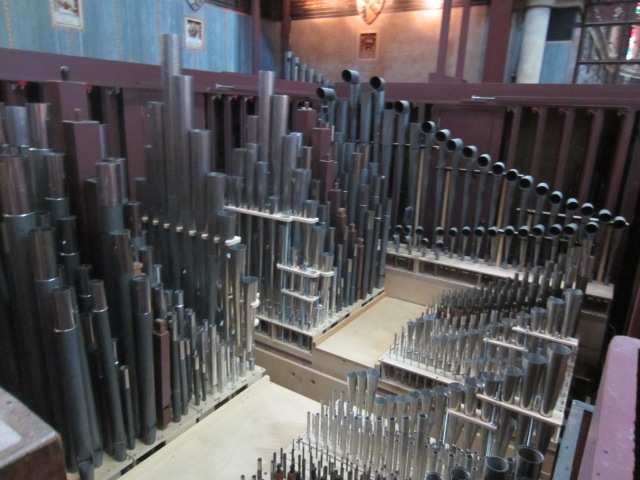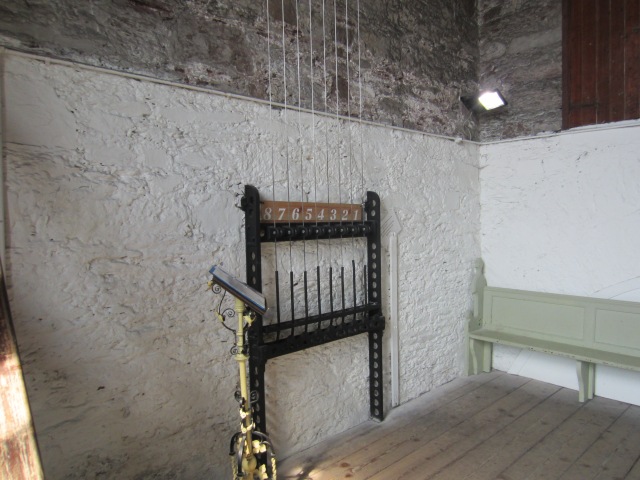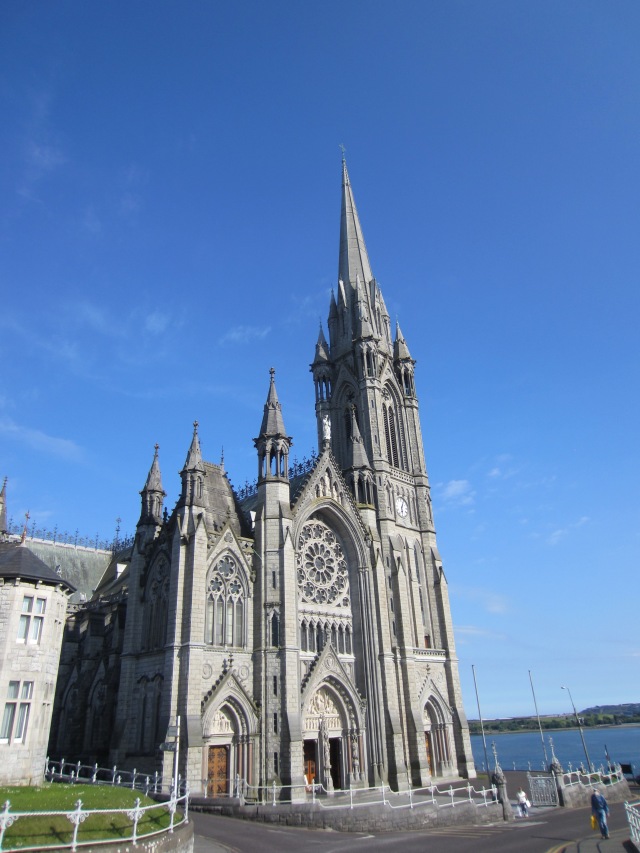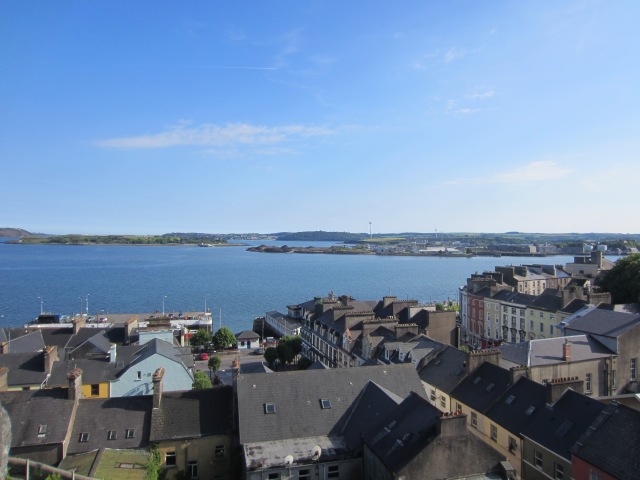*** Check out the first post of our trip to Ireland and read them in order! ***
After a bit of a late night writing, the morning came sooner than either of us wanted, but the excitement of the day helped get us motivated. We packed our belongings and set out from Kilkenny towards city of Cashel, home of a very popular set of ruins known as the Rock of Cashel. As we approached Cashel, we saw the ruins sitting atop a limestone outcrop on a hill overlooking the city.
When we arrived at the base of the hill at about 9:30, we learned that we would have to pay for parking, a theme that would carry throughout the day. We also noticed with some dismay that one tour bus was already there, though we didn’t see too many people yet. We quickly walked up the hill to the entrance of the site and learned that the first guided tour of the day would begin a few minutes. We stepped outside to await the start and admire the massively large structures.
Only a minute or two later, a large group of French tourists poured out of the Visitor’s Center and their guide began talking rapidly in French, presumably about the ruins. She finished her spiel and her group moved off into one of the buildings just in time for our tour to begin. In the less than 10 minutes since we had arrived, our group had grown to over 20 people. The website had indicated this site was very popular but we were still unprepared for the mass of humanity that was about to convene on this hilltop overlooking Cashel!
Our own guide (Seamus) took us around the site and explained the history of this location from a relatively small castle early last millennium to a massive cathedral complex in the centuries that followed. While he was talking, our heads were mostly pointed upwards admiring the vast quantities of stone in the ruined walls that still reached high into the sky.
The Rock of Cashel had many interesting aspects, though the highlights for us are the fresco remnants that have somehow survived the test of time and weather, as well as the towering overall structure. We’re not sure why these buildings feel so much larger than other places we’ve visited (and it’s likely that they aren’t really that much bigger), but something about the ruins on the top of the exposed hill just increases the impressiveness.
In one area, the walls had crumbled to reveal the narrow passageway between the inner and outer wall of the tower house where the stairwells were located. Our guide also explained how the various buildings on site (many of which shared walls) were connected and allowed for residents and guests to move between house and church without going outside into the cold.
We finished our tour in the graveyard around the structures and enjoyed the opportunity to step away from the ever increasing group of people around us. By the time we walked away from the Rock of Cashel and down through a poop-strewn path (thanks to the nearby sheep) towards a ruined abbey set a half kilometer or so down below, there were likely more than 200 people at the site with even more still arriving.
Unfortunately, we couldn’t find an easy way to get over to the abbey and didn’t relish the idea of jumping a fence and trudging through a field. Rather than climbing back up the hill we had just descended, we decided to follow the roads into Cashel instead with the hope of circumnavigating the hill back to our car. This walk turned out to be a flat and lovely stroll through a very quaint Cashel and we even managed to find a bakery on the way back to our car.
As we pulled out of the car park, the number of tour buses was up to 6 and we were quite glad we had come as early as we did. We weaved through the pedestrians and made our way out of Cashel and to our next castle located in the town of Cahir. When we arrived, we parked in the pay lot directly adjacent to the castle and walked towards the castle entrance. We took a moment to look at the river next to the castle and saw a very interesting triangle shaped waterfall in the river.
When we got to the entrance, we learned that part of the castle was closed due to electrical work. Fortunately, though, admission was free for the day as a result so we couldn’t complain too much. We walked across the castle courtyard and enjoyed the feeling of being mostly alone in this huge area (save for a few workers along one wall). Just before we reached a renovated building at the other end of the courtyard where we were to watch a 15 minute video, the doors opened up and a few dozen French tourists streamed out…so much for the serenity of the moment (pretty sure these were a different group than the ones we saw at Cashel).
The video gave an overview of the Cahir Castle, as well as some video and explanation of various other castles around Ireland. When it finished, we returned to the courtyard and began the process of wandering around to see what we could find.
According to our guidebook, Cahir Castle has been used a set for several movies and we could easily see why. The castle has been well maintained/renovated and still has the feeling of a fortress, rather than the rebranding as a palace or mansion that has taken place at some other castles we’ve seen (e.g., Kilkenny Castle).
In one section of the castle, we found a room with a grated hole in the wall, which we instantly recognized from the overview video as a medieval bathroom and toilet. We were somewhat surprised by the large size of the room, considering its purpose. We took a look around but decided to keep our hands off of certain areas for obvious reasons.
Just when Philip had assumed we had seen all there was to see, Rose pointed out a set of stairs in a corner that descended underground. Excited, we walked over to them and followed them down to the base of one of the castle towers. A very narrow staircase then branched off to the side, which we naturally followed and it took us up several floors until we emerged at the top of a tower overlooking the river below. It seemed that nobody else around knew about this area and we enjoyed the views for a few minutes on our own private tower. When ready, we returned back to the courtyard, just as an older couple was eying the stairs with some trepidation. We explained where they led and encouraged them to check it out, but English may not have been their first language so it wasn’t clear if they really understood what we were saying.
We then found an additional area we had not yet seen on the second floor inside one of the castle buildings. Inside, we found a large diorama depicting the order of events when the English lay siege to the castle centuries ago. As he tends to do, Philip spent a while studying the diorama and its intricate details.
After the castle, we walked to a large park directly behind it hoping to get some great views of the structure. Cahir Castle and the park sit on an island that is flanked by rivers on all sides. As we did a lap of the park, we enjoyed spectacular views of the castle and were able to see how the builders had built the walls directly on top of a rugged stone outcropping. While walking the outside of the walls, we noticed that some of the arrow slits appeared to be backwards. Typically, the wide part of an arrow slit is inside the area being defended, but in this case it was reversed. We have no idea why this may be the case and it seems like a very poor design decision for a defensible castle.
The walk around the park was one of the most peaceful times we have had yet in Ireland. The river flows slowly through this stretch and the vegetation is lush. Palatial houses sit on the opposite bank with what must be stunning views of the castle. Interestingly, there is also some sort of high ropes course apparatus crossing the river. Philip of course wanted to try it but Rose wisely said no and we both remained dry.
Quite satisfied with our visit to Cahir Castle, we returned to our car and drove onward to the small village of Blarney on the outskirts of the much larger city of Cork. Blarney is famous, of course, for Blarney Castle and its very well known chunk of rock, the Blarney Stone. We will be visiting the castle and hopefully kissing the stone tomorrow.
When we arrived at our B&B in Blarney, we realized we were 2 hours early for check in but we knocked on the door just in case the caretaker was there. We were greeted at the door by a somewhat frazzled Irish lady with the thickest accent we have heard yet. After speaking with her for a few minutes, we learned that she was having severe plumbing problems and several of her rooms were without water. As a result, she had negotiated with another B&B nearby to house us instead at the same rate.
With memories of our hotel situation in Otranto, Italy, running through our minds, we returned to our car and followed her husband to the other B&B. We checked in there and got some tips for how to spend the remainder of our day. We had already planned on going into Cork to see a few sites, but the owner suggested that we might visit the city of Cohb if we had time afterwards. Cohb was the last port of call for the Titanic prior to its fateful encounter with an iceberg.
We set off in our car for downtown Cork and quickly hit “end of the school day” traffic. Eventually, we made it through to a parking garage in close proximity to St. Finn Barre’s Cathedral. Being the frugal people we are, we decided to park on the roof of the garage since that was 1 euro per hour cheaper than parking inside of the structure (some may scoff at this amount of savings but over a 3 hour visit, that’s at least worth a cone of gelato and Philip doesn’t mess around when it comes to gelato!).
After parking, we walked a few blocks and came upon the incredible façade of St. Finn Barre’s Cathedral. The cathedral is of Gothic design and includes two bell towers flanking the front entrance, as opposed to the more common symmetrical arrangement of a single bell tower.
We entered the cathedral and attempted to pay for our tickets with a credit card, causing a look of panic to wash over the face of the young worker behind the counter who had apparently never had to ring up a card before. He quickly sought help and finished our transaction. We then inquired about the sign behind the counter that said free tours are available upon request. We were pleasantly surprised to learn that personal tours are offered on an impromptu basis. It seems that the cathedral does not get an exceptional amount of visitors and thus this service is possible.
We set off around the cathedral with our knowledgeable and somewhat hyper tour guide. He told us a lot of fascinating facts about the cathedral and about the eccentric nature of the architect (Rose knows a little something about eccentric architects). The cathedral is relatively modern, with the structure having been completed in the mid-19th century and some of the interior adornments being completed as late as the 1930’s. As might be expected, the cathedral is in exquisite condition. The adornments are extensive and include beautiful colored marble throughout. The cathedral also has an enormous pipe organ (possibly the largest in Ireland) with over 4000 pipes. It is especially unique because a large quantity of the pipes sit at ground level rather than being mounted high in the walls. A subset of pipes does reside at the back of the church above the entrance; these used to be mechanically activated but since the organ was recently renovated (at a cost of well over a million euros), they are now controlled via fiber optics.
After thanking our tour guide, we headed out of the cathedral and did a quick lap of the adjacent park. We then set off across Cork towards the Butter Museum. We first found ourselves in a somewhat icky industrial area but a timely one block adjustment to our path and the crossing of a river put us instead in a lovely pedestrian area. We made a quick stop for some curry chips (fries with a curry sauce) and continued towards our destination. Despite a brief detour when we thought we had gotten off track (would have been helpful to realize Cork has two rivers, not just one!), we eventually made it across the second river and up the hill to the Butter Museum.
We purchased our tickets to the museum and entered the gallery area. We sat for a while and watched a video produced no later than the early 1990’s about butter and its importance to this region of Ireland. Despite the questionable film quality, the information and history presented was actually fairly interesting. After the video finished, we walked around the 2 floors of the gallery briefly and looked at the various butter making artifacts. We also watched a video from the same era of awkward people awkwardly churning butter.
Truth be told, the butter museum was not the highlight of the day. Fortunately, the walk to that area of Cork revealed a clock/bell tower nearby, which ended up being far more satisfying to visit. We arrived there at 4:32 and were told we had made it just in time to climb the tower since they close promptly at 5pm. We paid our admission fee and were each handed ear protection to save our hearing when we were in the bell area.
This tower is unique amongst others we have been to in that they encourage visitors to ring the bells. On the first level of the tower, there is a songbook on a music stand next to 8 cords that descend from the ceiling along one wall. Each cord, when pulled, strikes the hammer of one of the bells and the 8 bells together make up a full octave. The songbook contains various popular songs (not that we had heard of many of them) and calls out which numbered bell should be rung and with what cadence. Philip had a fine time playing a few tunes including “Here Comes the Sun” and “This Land Is Your Land”. Fun fact: “This Land Is Your Land” actually has both American and Canadian versions. Who knew!
After playing the bells (and briefly wondering what it would be like to live near the bell tower), we climbed higher. We reached the third floor with the clock mechanism and spent a few moments looking at the intricate gears and equipment to drive a clock face on each side of the tower. We donned our ear protection and climbed to the fourth floor where the bells themselves hang out. This would be a wonderful place to spend some time if it weren’t for the very brave pigeons that also live there and the incredible mess they make. While we were there (and on our way back down later), somebody below rang the bells and we were very thankful for the ear protection. It was a cool experience to be basically crouching beneath a 1 meter diameter bell and see and hear the hammer strike it.
We then climbed to the top of the tower and out onto the exterior walkway. From here, we had views all over Cork and could see St. Finn Barre’s Cathedral off in the distance. While up there, we looked down into a small park next to the tower and noticed a few dogs running around. As might be expected, we now knew our next destination!
We climbed back down, returned our ear protection, and set off into the park where we met a beautiful husky and an Irish Setter mix (and said hi to their humans as well). A stroll back across Cork brought us back to our car. Rose validated and paid our parking fee while Philip got dizzy bringing the car down 6 stories of parking structure switchbacks.
As it was only about 5:15pm, we decided we would follow the advice of our new B&B owner and check out the town of Cohb, about 30ish minutes away. The “ish” in this case was important because we ended up stuck for several minutes in Cork’s evening rush hour traffic. Eventually, we made it through and the rest of the drive to Cohb was quite pleasant.
We pulled into town on a steep street that descended towards the ocean (probably more of a bay, actually) below. While seeing water for the first time since we landed on this island was nice, what really dominated our attention was a magnificent cathedral near the bottom of the road. We had no idea of what to expect when coming to Cohb, but we certainly hadn’t anticipated a cathedral of this magnificence.
We parked a few blocks up the street from St. Colman’s Cathedral and walked down to the building, taking pictures every few steps. We went inside and were instantly blown away by what we saw. Unlike most of the other churches we’ve seen in Ireland, this one is extremely ornate. In fact, it even blows away St. Finn Barre’s Cathedral, which itself had far surpassed any of the others we had seen. We walked around the interior in awe (that is the point of magnificence in a cathedral after all) and took it all in.
One aspect we found very interesting is the ornate, almost to the point of absurdity, stone carvings that cover a large percentage of the interior walls. In the nave, we realized that these were carved in the shape of shamrocks. In the transept, we saw a combination of fleur-du-lies and flower petals. We also noticed the mosaic tilework on the floors of the cathedral, which have a decidedly Celtic theme, as well as other green accents around the building. More than any other church we’ve seen, this one feels the most Irish.
After we picked our jaws up off the floor, we went back outside and stood for a few minutes looking over the ocean and then walked back up the hill towards our car to find food. We stepped into a small corner take away restaurant called Sorrento Pizza (or something like that). Rose ordered a taco pizza…yes, an American ordering Mexican-themed food in an Italian-inspired restaurant in Ireland. Philip ordered some fish and chips and we chatted with the female worker for a few minutes while we waited for our food.
Philip asked her if she was from Sorrento, thus beginning an always welcome conversation about Italy. We told her about our previous adventures in Italy and then took our food and left. We walked around for a few minutes hoping to find a place to sit and eat, but eventually ended up just sitting in the car. The view from there was fantastic so we really didn’t mind. After eating way too much food, we realized we were out of water and both thirsty so we set off back down the hill 1 block to a small grocery store.
Before we made it more than 20 feet, Philip felt the gravitational pull of puppies and we stopped to talk to a man and meet his two dogs: a husky and a border collie mix (yes, Philip was momentarily in heaven). As he petted both dogs, the border collie kept nibbling on Philip’s hand, just like Niko! After a minute or two, we completed our journey to the market and then returned back to our B&B in Blarney to call it a night (after some writing and pictures, of course).
Today was pretty awesome and the unexpected journey to Cohb was a satisfying finish. Tomorrow, we head west, though not before stopping at Blarney Castle to do that quintessential Irish tradition: kissing the Blarney Stone.
Summary:
- The Rock of Cashel and the deluge of tour buses
- Exploring Cahir Castle and finding our own tower
- Memories of Otranto: the B&B switch
- Our private tour of St. Finn Barre’s Cathedral
- “Butter makes it better”…unless it is a museum
- Playing the church bells over Cork
- An impromptu visit to Cohb and discovering its awesome cathedral
- A little touch of Italy in southern Ireland
Stats:
- Total Distance Traveled: 234.82 km
- Distance on Foot: 13.83 km | 18,737 steps

